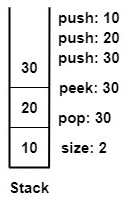Design Stack using Linked List | Stack Problem | Java with Generics
4 years ago Lalit Bhagtani 0
Problem Statement
Design a Stack (LIFO) data structure using Linked List. The Stack data structure will supports the following operations:
- push(N) :- It insert element N onto the top of the stack.
- pop() :- It removes and returns the element from the top of the stack.
- peek() :- It returns (not remove) the element from the top of the stack.
- isEmpty() :- It checks whether the stack is empty or not.
- size() :- It return the total number of elements.
- iterator() :- It returns the java iterator object for iterating through the elements of the stack.
Example

Stack stack = new Stack();
stack.push(10);
stack.push(20);
stack.push(30);
stack.peek(); -- value: 30
stack.pop(); -- value: 30
stack.isEmpty(); -- value: false
stack.size(); -- value: 2
Solution
Each node of linked list will contain two parts :
- Data Part:- It contains the value to be pushed into the stack.
- Next Part:- It contains pointer the next value in the stack.
Each operation of the stack will work in the following way:
- push(N) :- It creates and inserts a new node to the head of the linked list. Node’s data part contains element N, next part contains the current head of the linked list.
- pop() :- It removes and returns the head node and makes node next to the head node as a new head of the linked list.
- peek() :- It returns data part of the head node.
- isEmpty() :- If head of the linked list is null, then returns true otherwise returns false.
- size() :- It traverses the linked list and count the total number of nodes and return the count.
- iterator() :- It returns the object of StackIterator class.
Stack Interface
public interface Stack<T> extends Iterable<T> {
public void push(T t);
public T pop();
public T peek();
public boolean isEmpty();
public int size();
}
Stack Implementation
import java.util.Iterator;
public class LinkedListStack<T> implements Stack<T> {
private Node head;
@Override
public void push(T t) {
Node node = head;
head = new Node();
head.element = t;
head.next = node;
}
@Override
public T pop() {
T t = head.element;
head = head.next;
return t;
}
@Override
public T peek() {
if(head != null) {
return head.element;
}
return null;
}
@Override
public boolean isEmpty() {
return head == null;
}
@Override
public int size() {
Node temp = head;
int count = 0;
while(temp != null){
temp = temp.next;
count++;
}
return count;
}
private class Node{
T element;
Node next;
}
@Override
public Iterator<T> iterator() {
return new StackIterator<T>(head);
}
private class StackIterator<T> implements Iterator<T>{
private LinkedListStack<T>.Node head;
public StackIterator(LinkedListStack<T>.Node head) {
super();
this.head = head;
}
@Override
public boolean hasNext() {
return head !=null;
}
@Override
public T next() {
if(head != null){
T t = head.element;
head = head.next;
return t;
}else {
throw new RuntimeException("Iterator Exhuested Exception");
}
}
}
}
Similar Post
That’s all for Design Stack using Linked List in Java, If you liked it, please share your thoughts in a comments section and share it with others too.
